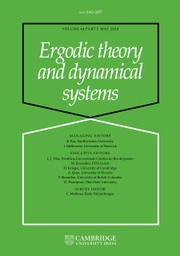Article contents
On the existence of non-hyperbolic ergodic measures as the limit of periodic measures
Published online by Cambridge University Press: 12 February 2018
Abstract
Gorodetski et al. [Nonremovability of zero Lyapunov exponents. Funktsional. Anal. i Prilozhen.39(1) (2005), 27–38 (in Russian); Engl. Transl. Funct. Anal. Appl.39(1) (2005), 21–30] and Bochi et al. [Robust criterion for the existence of nonhyperbolic ergodic measures. Comm. Math. Phys.344(3) (2016), 751–795] propose two very different ways for building non-hyperbolic measures, Gorodetski et al. (2005) building such a measure as the limit of periodic measures and Bochi et al. (2016) as the  $\unicode[STIX]{x1D714}$-limit set of a single orbit, with a uniformly vanishing Lyapunov exponent. The technique in Gorodetski et al. (2005) has been used in a generic setting in Bonatti et al. [Non-hyperbolic ergodic measures with large support. Nonlinearity23(3) (2010), 687–705] and Díaz and Gorodetski [Non-hyperbolic ergodic measures for non-hyperbolic homoclinic classes. Ergod. Th. & Dynam. Sys.29(5) (2009), 1479–1513], as the periodic orbits were built by small perturbations. It is not known if the measures obtained by the technique in Bochi et al. (2016) are accumulated by periodic measures. In this paper we use a shadowing lemma from Gan [A generalized shadowing lemma. Discrete Contin. Dyn. Syst.8(3) (2002), 527–632]:
$\unicode[STIX]{x1D714}$-limit set of a single orbit, with a uniformly vanishing Lyapunov exponent. The technique in Gorodetski et al. (2005) has been used in a generic setting in Bonatti et al. [Non-hyperbolic ergodic measures with large support. Nonlinearity23(3) (2010), 687–705] and Díaz and Gorodetski [Non-hyperbolic ergodic measures for non-hyperbolic homoclinic classes. Ergod. Th. & Dynam. Sys.29(5) (2009), 1479–1513], as the periodic orbits were built by small perturbations. It is not known if the measures obtained by the technique in Bochi et al. (2016) are accumulated by periodic measures. In this paper we use a shadowing lemma from Gan [A generalized shadowing lemma. Discrete Contin. Dyn. Syst.8(3) (2002), 527–632]:
∙ for getting the periodic orbits in Gorodetski et al. (2005) without perturbing the dynamics;
∙ for recovering the compact set in Bochi et al. (2016) with a uniformly vanishing Lyapunov exponent by considering the limit of periodic orbits.
As a consequence, we prove that there exists an open and dense subset  ${\mathcal{U}}$ of the set of robustly transitive non-hyperbolic diffeomorphisms far from homoclinic tangencies, such that for any
${\mathcal{U}}$ of the set of robustly transitive non-hyperbolic diffeomorphisms far from homoclinic tangencies, such that for any  $f\in {\mathcal{U}}$, there exists a non-hyperbolic ergodic measure with full support and approximated by hyperbolic periodic measures. We also prove that there exists an open and dense subset
$f\in {\mathcal{U}}$, there exists a non-hyperbolic ergodic measure with full support and approximated by hyperbolic periodic measures. We also prove that there exists an open and dense subset  ${\mathcal{V}}$ of the set of diffeomorphisms exhibiting a robust cycle, such that for any
${\mathcal{V}}$ of the set of diffeomorphisms exhibiting a robust cycle, such that for any  $f\in {\mathcal{V}}$, there exists a non-hyperbolic ergodic measure approximated by hyperbolic periodic measures.
$f\in {\mathcal{V}}$, there exists a non-hyperbolic ergodic measure approximated by hyperbolic periodic measures.
- Type
- Original Article
- Information
- Copyright
- © Cambridge University Press, 2018
References
- 4
- Cited by


